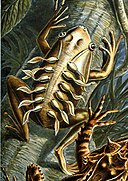Vaizdas:Haeckel Batrachia.jpg

Šios peržiūros dydis: 424 × 599 taškų. Kitos 5 rezoliucijos: 170 × 240 taškų | 339 × 480 taškų | 543 × 768 taškų | 724 × 1 024 taškų | 2 323 × 3 284 taškų.
Didesnės raiškos iliustracija (2 323 × 3 284 taškų, rinkmenos dydis: 2,17 MiB, MIME tipas: image/jpeg)
Rinkmenos istorija
Paspauskite ant datos/laiko, kad pamatytumėte rinkmeną tokią, kokia ji buvo tuo metu.
| Data/Laikas | Miniatiūra | Matmenys | Naudotojas | Paaiškinimas | |
|---|---|---|---|---|---|
| dabartinis | 06:17, 24 vasario 2006 |  | 2 323 × 3 284 (2,17 MiB) | Ragesoss | improve version, based on same original scan |
| 03:22, 11 vasario 2006 |  | 2 318 × 3 280 (2,21 MiB) | Ragesoss | The 68th plate from Ernst Haeckel's 1899 ''Kunstformen der Natur'', depicting frogs classified as Batrachia. Category:Ernst Haeckel |
Paveikslėlio naudojimas
Paveikslėlis yra naudojamas šiuose puslapiuose:
Visuotinis rinkmenos naudojimas
Ši rinkmena naudojama šiose viki svetainėse:
- Naudojama arz.wikipedia.org
- Naudojama ast.wikipedia.org
- Naudojama az.wikipedia.org
- Naudojama ban.wikipedia.org
- Naudojama be.wikipedia.org
- Naudojama bg.wikipedia.org
- Naudojama ca.wikipedia.org
- Naudojama ca.wikibooks.org
- Naudojama ceb.wikipedia.org
- Naudojama ckb.wikipedia.org
- Naudojama dag.wikipedia.org
- Naudojama de.wikipedia.org
- Naudojama din.wikipedia.org
- Naudojama el.wikipedia.org
- Naudojama en.wikipedia.org
- Wikipedia:Featured pictures thumbs/04
- Wikipedia:Picture of the day/June 2006
- User:Ragesoss/Haeckel
- Wikipedia:Featured picture candidates/Haeckel Batrachia.jpg
- Wikipedia:Wikipedia Signpost/2006-03-13/Features and admins
- Wikipedia:Featured picture candidates/March-2006
- Talk:Frog/Archive 3
- User talk:Ragesoss/Archive1
- Wikipedia:Picture of the day/June 12, 2006
- Wikipedia:POTD/June 12, 2006
- Wikipedia:POTD column/June 12, 2006
- Wikipedia:POTD row/June 12, 2006
- Kunstformen der Natur
- User:Samsara/Frog/Stable
- User:RichardF/POTD
- Wikipedia:WikiProject Germany/Gallery
- User talk:RichardF
- User:Froggyyes~enwiki
- Wikipedia:Featured pictures/Animals/Amphibians
- Unclean spirit
- User:Xophist/s5
- Wikipedia:Wikipedia Signpost/2006-03-13/SPV
- Talk:Alfred Russel Wallace/Archive 1
- Portal:Amphibians/Selected picture
- User:The Transhumanist/Sandbox144
Žiūrėti visuotinį šios rinkmenos naudojimą.








